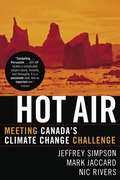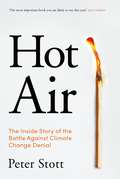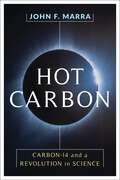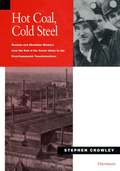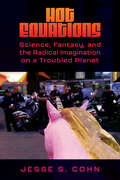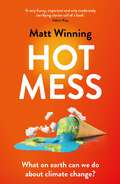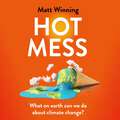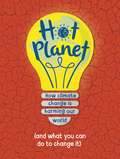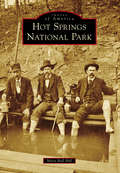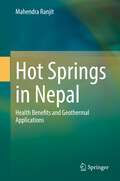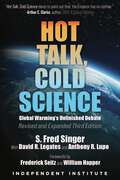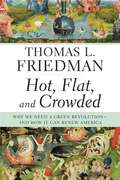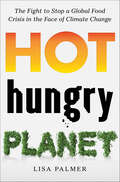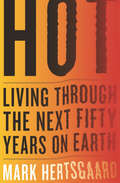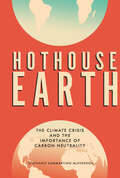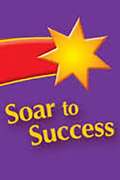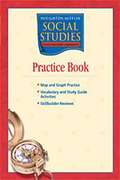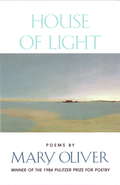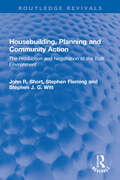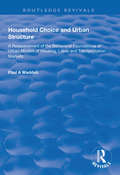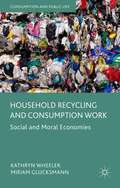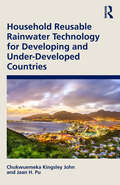- Table View
- List View
Hot Air: Meeting Canada's Climate Change Challenge
by Jeffrey Simpson Nic Rivers Mark JaccardHere's a clear, believable book for Canadians concerned about our situation -- and it offers a solution. It's a brilliant mix. To "Canada's best mind on the environment," Mark Jaccard, who won the 2006 Donner Prize for an academic book in this area, you add Nic Rivers, a researcher who works with him at Simon Fraser University. Then you add Jeffrey Simpson, the highly respected Globe and Mail columnist, to punch the message home in a clear, hard-hitting way. The result is a unique book.Most other books on energy and climate change are: (a) terrifying or (b) academic or (c) quirky, advocating a single, neat solution like solar or wind power. This book is different. It starts with an alarming description of the climate threat to our country. Then it shifts to an alarming description of how Canadians have been betrayed by their politicians ("We're working on it!"), their industrialists ("Things aren't that bad, really, and voluntary guidelines will be good enough."), and even their environmentalists ("Energy efficiency can be profitable, and people can change their lifestyles!") All of this, of course, reinforces the myths that forceful policies are not needed. Hot Air then lays out in convincing and easily understandable terms the few simple policies that Canada must adopt right away in order to significantly reduce greenhouse gas emissions over the next few decades. It even shows how these policies can be designed to have minimal negative effects. With evidence from other countries that are successfully addressing climate change, Hot Air shows why these are the only policies that will work -- and why this is a matter of life and death for all of us.
Hot Air: The Inside Story of the Battle Against Climate Change Denial
by Peter StottThe shocking inside story of the fight to halt climate change over the past twenty-five years by a world-renowned scientist.Ours is the age of global warming. Rising sea levels, extreme weather, forest fires. Dire warnings are everywhere, so why has it taken so long for the crisis to be recognised?Here, for the first time, climate scientist Peter Stott reveals the bitter fight to get international recognition for what, among scientists, has been known for decades: human activity causes climate change. Across continents and against the efforts of sceptical governments, prominent climate change deniers and shadowy lobbyists, Hot Air is the urgent story of how the science was developed, how it has been repeatedly sabotaged and why humanity hasn't a second to spare in the fight to halt climate change.
Hot Carbon: Carbon-14 and a Revolution in Science
by Professor John F. MarraThere are few fields of science that carbon-14 has not touched. A radioactive isotope of carbon, it stands out for its unusually long half-life. Best known for its application to estimating the age of artifacts—carbon dating—carbon-14 helped reveal new chronologies of human civilization and geological time. Everything containing carbon, the basis of all life, could be placed in time according to the clock of radioactive decay, with research applications ranging from archeology to oceanography to climatology.In Hot Carbon, John F. Marra tells the untold story of this scientific revolution. He weaves together the workings of the many disciplines that employ carbon-14 with gripping tales of the individuals who pioneered its possibilities. He describes the concrete applications of carbon-14 to the study of all the stuff of life on earth, from climate science’s understanding of change over time to his own work on oceanic photosynthesis with microscopic phytoplankton. Marra’s engaging narrative encompasses nuclear testing, the peopling of the Americas, elephant poaching, and the flax plants used for the linen in the Shroud of Turin. Combining colorful narrative prose with accessible explanations of fundamental science, Hot Carbon is a thought-provoking exploration of how the power of carbon-14 informs our relationship to the past.
Hot Coal, Cold Steel: Russian and Ukrainian Workers from the End of the Soviet Union to the Post-communist Transformations
by Stephen CrowleyWell after the disintegration of the Communist Party and the Soviet state--and through several years of economic collapse--industrial workers in almost every sector of the former Soviet Union have remained quiescent and the same ineffective and unpopular trade unions still hold a virtual monopoly on worker's representation. Why? While many argue that labor is a central variable in the development of economic and political systems, little is known about workers in the states of the former Soviet Union since the fall of Communism. In a comparative study of two groups of industrial workers--the coal miners and steelworkers--at the end of the Soviet era, Stephen Crowley sheds light on where these workers have been and where they are going. Coal miners in the final years of the Soviet Union effectively organized and led strikes which supported the end of Communism, even though their heavy subsidies would be threatened by capitalism. Steel workers, in contrast, did not effectively organize and strike. This pattern has continued under the new governments, with the coal miners effectively organized and seeking protection from the worst consequences of marketization, while the steel workers remain weakly organized despite deteriorating economic conditions. Based on extensive on-site research including interviews with miners and steelworkers, labor leaders and plant managers, Crowley develops a detailed picture of the conditions under which workers organize. His findings have application beyond the conditions of post-Communist Russia and Ukraine to other societies undergoing fundamental change.
Hot Equations: Science, Fantasy, and the Radical Imagination on a Troubled Planet
by Jesse S. CohnInspired by the new diversity of science fiction, fantasy, and horror in the twenty-first century, Hot Equations: Science, Fantasy, and the Radical Imagination on a Troubled Planet confronts the kinds of literary and political “realism” that continue to suppress the radical imagination. Alluding both to the ongoing climate catastrophe and to Tom Godwin’s “The Cold Equations”—that famous touchstone of “hard science fiction”—Hot Equations reads the crises of our "post-normal" moment via works that increasingly subvert genre containment and spill out into the public sphere. Drawing on archives and contemporary theory, author Jesse S. Cohn argues that these imaginative works of science fiction, fantasy, and horror strike at the very foundations of modernity, calling its basic assumptions into question. They threaten the modern order with a simultaneously terrible and promising anarchy, pointing to ways beyond the present medical, ecological, and political crises of pandemic, climate change, and rising global fascism. Examining books ranging from well-known titles like The Hunger Games and The Caves of Steel to newer works such as Under the Pendulum Sun and The Stone Sky, Cohn investigates the ways in which science fiction, fantasy, and horror address contemporary politics, social issues, and more. The “cold equations” that established normal life in the modern world may be in shambles, Cohn suggests, but a New Black Fantastic makes it possible for the radical imagination to glimpse viable possibilities on the other side of crisis.
Hot Mess: What on earth can we do about climate change?
by Matt Winning'A very funny, important and only moderately terrifying clarion call of a book' - Adam Kay'HOT MESS provides loads of laughs about "the climate situation" and will position you at the right point between fear and determination' - Mark Watson 'Hilarious, informative and worrying in equal measure. And that's just the bits about having a baby' - Josie LongFor fans of Randall Munro's WHAT IF? Matt Parker's HUMBLE PI and anyone looking for practical tips on how to stop the end of the world!Dr Matt Winning is a stand-up comedian and environmental economist with a PHD in climate change policy, which means he's the sort of doctor who will rush to your side if you fall ill on a plane, but only to berate you for flying. We are currently facing a global climate emergency. You've probably noticed. But why does the end of the world need to be so depressing? HOT MESS aims to both lighten the mood and enlighten readers on climate change. This is a book for people who care about climate change but aren't doing much about it, helping readers understand what the main causes of climate change are, what changes are needed, and what they can (and cannot) do about it. But, most importantly, it is book that'll help people find the comedy in climate change, because if we can do that, well, we can do bloody anything.'Climate change is no laughing matter - oh yes it is - with Matt Winning's superb, hilarious, side-splitting book that makes you take a whole new look at the climate crisis, surviving having children and life in general' - Mark Maslin, author of How to Save Our Planet'The first book about climate change that made me laugh out loud. If you've been too freaked out to subject yourself to the climate crisis, Hot Mess is the kick in the pants you need to start making yourself useful.' - Prof. Kimberly Nicholas, author of Under the Sky We Make: How to Be Human in a Warming World
Hot Mess: What on earth can we do about climate change?
by Matt Winning'A very funny, important and only moderately terrifying clarion call of a book' - Adam Kay'HOT MESS provides loads of laughs about "the climate situation" and will position you at the right point between fear and determination' - Mark Watson 'Hilarious, informative and worrying in equal measure. And that's just the bits about having a baby' - Josie LongFor fans of Randall Munro's WHAT IF? Matt Parker's HUMBLE PI and anyone looking for practical tips on how to stop the end of the world!Dr Matt Winning is a stand-up comedian and environmental economist with a PHD in climate change policy, which means he's the sort of doctor who will rush to your side if you fall ill on a plane, but only to berate you for flying. We are currently facing a global climate emergency. You've probably noticed. But why does the end of the world need to be so depressing? HOT MESS aims to both lighten the mood and enlighten readers on climate change. This is a book for people who care about climate change but aren't doing much about it, helping readers understand what the main causes of climate change are, what changes are needed, and what they can (and cannot) do about it. But, most importantly, it is book that'll help people find the comedy in climate change, because if we can do that, well, we can do bloody anything.'Climate change is no laughing matter - oh yes it is - with Matt Winning's superb, hilarious, side-splitting book that makes you take a whole new look at the climate crisis, surviving having children and life in general' - Mark Maslin, author of How to Save Our Planet'The first book about climate change that made me laugh out loud. If you've been too freaked out to subject yourself to the climate crisis, Hot Mess is the kick in the pants you need to start making yourself useful.' - Prof. Kimberly Nicholas, author of Under the Sky We Make: How to Be Human in a Warming World
Hot Mess: What on earth can we do about climate change?
by Matt WinningWhat is climate change, who's to blame, and what the f**k can we do about it? Award-winning comedian and climate change researcher Dr Matt Winning explains all.For fans of Randall Munro's WHAT IF? Matt Parker's HUMBLE PI and anyone looking for practical tips on how to stop the end of the world!Dr Matt Winning is a stand-up comedian and environmental economist with a PHD in climate change policy, which means he's the sort of doctor who will rush to your side if you fall ill on a plane, but only to berate you for flying. We are currently facing a global climate emergency. You've probably noticed. But why does the end of the world need to be so depressing? HOT MESS aims to both lighten the mood and enlighten readers on climate change. This is a book for people who care about climate change but aren't doing much about it, helping readers understand what the main causes of climate change are, what changes are needed, and what they can (and cannot) do about it. But, most importantly, it is book that'll help people find the comedy in climate change, because if we can do that, well, we can do bloody anything.(P) 2021 Headline Publishing Group Ltd
Hot Planet: How climate change is harming Earth (and what you can do to help)
by Anna ClaybourneHot Planet offers young readers the perfect, non-alarmist introduction to Earth's climate change crisis Climate change is a new reality in today's world. From melting ice caps to forest fires, climate change is responsible for dramatic freak weather events and Earth is now warmer than it has been at any point in the last 650,000 years.Hot Planet aims to raise readers aged nine and up's awareness of the challenges of climate change in a non-alarmist, yet realistic, way. It explores what climate change is, what is believed to cause it, its current impact on the world and what might happen in the future if it progresses at current rates. It also highlights the social inequality of climate change, as richer and more industrialised countries contribute far more heavily to climate change through their energy consumption, yet poorer, less developed nations are currently much more affected by it.The book looks ahead at how we can all help combat the climate change crisis, from global changes such as investing in sustainable energy sources to reduce our dependence on fossil fuels, to green schemes such as carbon pricing, to practical solutions such as eating less meat and using public transport or cycling, rather than driving. The author, Anna Claybourne, is an award-winning science writer.
Hot Springs National Park
by Mary Bell HillHot Springs was one of the first areas set aside as a federal land reservation in 1832--predating the first national park at Yellowstone by 40 years. In 1921, it was officially designated a national park. Physically the smallest of the 59 US national parks today, Hot Springs measures just larger than 5,500 acres. Its 47 on-site springs produce more than 700,000 gallons of thermal water per day. From early natives who quarried novaculite found in the surrounding hills to famous politicians, performers, and athletes, people have been coming to these springs for thousands of years to partake in the supposed healing powers of the water. Pres. Franklin Roosevelt, boxer Jack Dempsey, and French opera diva Lily Pons are a few of the visitors who made the trek to the "Valley of the Vapors." The history of Hot Springs National Park revolves around peoples' interactions with its thermal water.
Hot Springs in Nepal: Health Benefits and Geothermal Applications
by Mahendra RanjitThis book presents a profile of the majority of hot springs in and around tourist destinations in Nepal. In particular, there is a focus on Pokhara, Jumla, the world- famous Annapurna region, Ruby Valley, and Api Nampa Conservation Area. The chapter on health benefits of mineral hot springs provides a history of hot springs supported by a literature review and case study. Further chapters explore the direct uses of geothermal energy for various purposes and power generation, together with a section on conventional hydrothermal resources. This book is of interest to the general public, students, national and international researchers, energy planners, and health professionals. The book is a valuable tool for sociologists who want to gain insight into the cultural and religious aspects of hot water mineral springs.
Hot Talk, Cold Science: Global Warming's Unfinished Debate
by S. Fred Singer David R. Legates Anthony R. LupoThe revised and expanded third edition of Hot Talk, Cold Science forms the capstone of the distinguished astrophysicist Dr. S. Fred Singer&’s lucid, yet hard scientific look at climate change. And the book is no less explosive than its predecessors—and certainly never more timely.Singer explores the inaccuracies in historical climate data and the failures of climate models, as well as the impact of solar variability, clouds, ocean currents, and sea levels on global climate—plus factors that could mitigate any human impact on world climate. Singer&’s masterful analysis decisively shows that the pessimistic, and often alarming, global-warming scenarios depicted in the media have no scientific basis. In fact, he finds that many aspects of increased levels of CO2, as well as any modest warming, such as a longer growing seasons for food and a reduced need to use fossil fuels for heating, would have a highly positive impact on the human race. As alarmists clamor to impose draconian government restrictions on entire populations in order to combat "climate change," this book reveals some other startling, stubborn contradictory facts, including: CO2 has not caused temperatures or sea levels to rise beyond historical rates. Severe storms have not increased in frequency or intensity since 1970—neither have heat waves nor droughts. Global "climate change" is not harming coral reefs. Any increases in CO2 concentrations across huge time spans haven't preceded rising global temperatures, they&’ve followed them by about 600 to 800 years—just the opposite of alarmist claims. "Carbon" taxes and other "solutions" to the global warming "crisis" would have severe consequences for economically disadvantaged groups and nations. Alarmist climate scientists have hidden their raw temperature data and deleted emails—then undermined the peer-review system to squelch debate. In sum, despite all the hot talk—and outright duplicity—there is no "climate crisis" resulting from human activities and no such threat on the horizon.
Hot, Flat, and Crowded: Why We Need a Green Revolution - and How It Can Renew America
by Thomas L. FriedmanFriedman shows how the 2 biggest crises of today (America's loss of focus since 9/11 and the global environment crisis) are linked and how we can restore the world and revive America at the same time
Hot, Hungry Planet: The Fight to Stop a Global Food Crisis in the Face of Climate Change
by Lisa PalmerEarth will have more than 9.6 billion people by 2050 according to U.N. predictions. With resources already scarce, how will we feed them all? Journalist Lisa Palmer has traveled the world for years documenting the cutting-edge innovations of people and organizations on the front lines of fighting the food gap. Here, she shares the story of the epic journey to solve the imperfect relationship between two of our planet’s greatest challenges: climate change and global hunger.Hot, Hungry Planet focuses on three key concepts that support food security and resilience in a changing world: social, educational, and agricultural advances; land use and technical actions by farmers; and policy nudges that have the greatest potential for reducing adverse environmental impacts of agriculture while providing more food. Palmer breaks down this difficult subject though seven concise and easily-digestible case studies over the globe and presents the stories of individuals in six key regions—India, sub-Saharan Africa, the United States, Latin America, the Middle East, and Indonesia—painting a hopeful picture of both the world we want to live in and the great leaps it will take to get there.
Hot: Living Through the Next Fifty Years on Earth (National Climate Seminar Ser. #5)
by Mark HertsgaardA fresh take on climate change by a renowned journalist driven to protect his daughter, your kids, and the next generation who'll inherit the problem For twenty years, Mark Hertsgaard has investigated global warming for outlets including the New Yorker, NPR, Time, Vanity Fair, and The Nation. But the full truth did not hit home until he became a father and, soon thereafter, learned that climate change had already arrived-a century earlier than forecast-with impacts bound to worsen for decades to come. Hertsgaard's daughter Chiara, now five yea rs old, is part of what he has dubbed "Generation Hot"--the two billion young people worldwide who will spend the rest of their lives coping with mounting climate disruption. HOT is a father's cry against climate change, but most of the book focuses on s olutions, offering a deeply reported blueprint for how all of us-as parents, communities, companies and countries-can navigate this unavoidable new era. Combining reporting from across the nation and around the world with personal reflections on his daugh ter's future, Hertsgaard provides "pictures" of what is expected over the next fifty years: Chicago's climate transformed to resemble Houston's; dwindling water supplies and crop yields at home and abroad; the redesign of New York and other cities against mega-storms and sea-level rise. Above all, he shows who is taking wise, creative precautions. For in the end, HOT is a book about how we'll survive.
Hothouse Earth: The Climate Crisis and the Importance of Carbon Neutrality
by Stephanie Sammartino McPhersonAs hurricanes, droughts, floods, and wildfires are increasing in regularity and intensity, climate change can no longer be ignored. Melting permafrost, forest dieback, ocean acidification, and other processes are creating positive feedback loops which could, if not aggressively and quickly addressed, spiral out of control and take global warming past the point of no return. Hothouse Earth examines how science, politics, and social justice must all be part of the equation to counteract climate change.
Hotshots!
by Chris L. DemarestSparks from a train ignite a field baked for days. Then winds whip it into a fast-running blaze. With fire now spreading out of control, the hotshots are called. They're ready to roll. What are hotshots?They are an elite ground fire-fighting corps of men and women highly trained to understand the scientific nature of fire in order to go deep into the heart of a wildfire, beyond the reach of hose lines, to limit the destruction of land and wildlife. As more homes are being built into the natural landscape, the role of the hotshot in fighting fire has become increasingly important. With stunning pictures and an action-packed text, fine artist and volunteer firefighter Chris L. Demarest here captures the spirit of the dedicated hotshots and the real-life drama of the dangerous work they must do every day.
Houghton Mifflin Discovery Works: Earth's Water
by Silver Burdett GinnWhere are sources of fresh water found? Think about where the water you use every day comes from. Is it brought by pipes from a faraway reservoir like the one shown? Does it come from a well drilled deep in the ground? Or does it come from some other source? What things in water can be harmful? Building a model of a water-filtering system will help you investigate how water that is dirty and unsafe is made clean and safe for drinking.
Houghton Mifflin Social Studies: World Cultures and Geography, Practice Book
by Houghton MifflinNIMAC-sourced textbook
House Gods: Sustainable Buildings and Renegade Builders
by Jim KristoficOur buildings are making us sick. Our homes, offices, factories, and dormitories are, in some sense, fresh parasites on the sacred Earth, Nahasdzáán. In search of a better way, author Jim Kristofic journeys across the Southwest to apprentice with architects and builders who know how to make buildings that will take care of us. This is where he meets the House Gods who are building to the sun so that we can live on Earth. Forever.In House Gods, Kristofic pursues the techniques of sustainable building and the philosophies of its practitioners. What emerges is a strange and haunting quest through adobe mud and mayhem, encounters with shamans and stray dogs, solar panels, tragedy, and true believers. It is a story about doing something meaningful, and about the kinds of things that grow out of deep pain. One of these things is compassion—from which may come solace. We build our buildings, we make our lives—we are the House Gods.
House of Light
by Mary OliverThis collection of poems by Mary Oliver once again invites the reader to step across the threshold of ordinary life into a world of natural and spiritual luminosity.Tell me, what is it you plan to dowith your one wild and precious life?—Mary Oliver, "The Summer Day" (one of the poems in this volume)Winner of a 1991 Christopher AwardWinner of the 1991 Boston Globe Lawrence L. Winship Book AwardThis book was published with two different covers. Customers will be shipped the book with one of the available covers.
Housebuilding, Planning and Community Action: The Production and Negotiation of the Built Environment (Routledge Revivals)
by Stephen Fleming John R. Short Stephen J. WittFirst published in 1986, Housebuilding, Planning and Community Action was written as an examination of the conflicts and tensions resulting from private sector housing growth in Central Berkshire, part of Britain’s ‘Silicon Valley’ along the M4 motorway. The book provides a detailed consideration of the various ‘actors’ and their interactions and explores the fight from Community groups and parish councils to halt development, in opposition to the government’s reluctance to discourage economic growth. It focuses on four groups closely involved in the production, allocation, and consumption of new housing: speculative housebuilders, local planning authorities, parish councils, and community/residents’ groups. The motivations and actions of each group are examined, and the tensions between them are highlighted, set within the context of central government attitudes towards planning and private housebuilding. Housebuilding, Planning and Community Action has lasting relevance for those interested in human geography, and the history of housebuilding and planning.
Household Choice and Urban Structure: A Re-Assessment of the Behavioural Foundations of Urban Models of Housing, Labor and Transportation Markets (Routledge Revivals)
by Paul A. WaddellPublished in 1997. The aim of this book is to explore urban modelling traditions, identify key limitations and contributions and to develop a more general model within a discrete choice framework. The scope of the effort is on household choices regarding residential location, workplace and housing tenure. It is the first systematic effort to analyze the structure and sequence of the choices made by households regarding residential location and workplace. The implications for urban theory, model development and policy analysis are substantial.
Household Recycling and Consumption Work: Social and Moral Economies (Consumption and Public Life)
by Kathryn Wheeler Miriam GlucksmannConsumers are not usually incorporated into the sociological concept of 'division of labour', but using the case of household recycling, this book shows why this foundational concept needs to be revised.
Household Reusable Rainwater Technology for Developing and Under-Developed Countries
by Jaan H. Pu Chukwuemeka Kingsley JohnHousehold Reusable Rainwater Technology for Developing and Under-Developed Countries provides insight into household techniques for collecting and treating harvested rainwater safely for both potable and nonpotable uses, as well as practices to improve its quality, with numerous realworld case studies and data. It gives a comprehensive, holistic account on the household scale for both developing and under-developed countries. Improvement mechanisms such as the impacts of first flush, household water treatment techniques, and sedimentation in the harvested water are described in depth together with the advantages and disadvantages of their common practices in developing and under-developed societies. Also discussed is a comprehensive survey illustrating the impact of rainwater sources on the daily life of a carefully selected community from the perspective of its residents. The book is ideal for students, researchers, academics, water policy providers, and bodies worldwide such as WHO and DFID.
